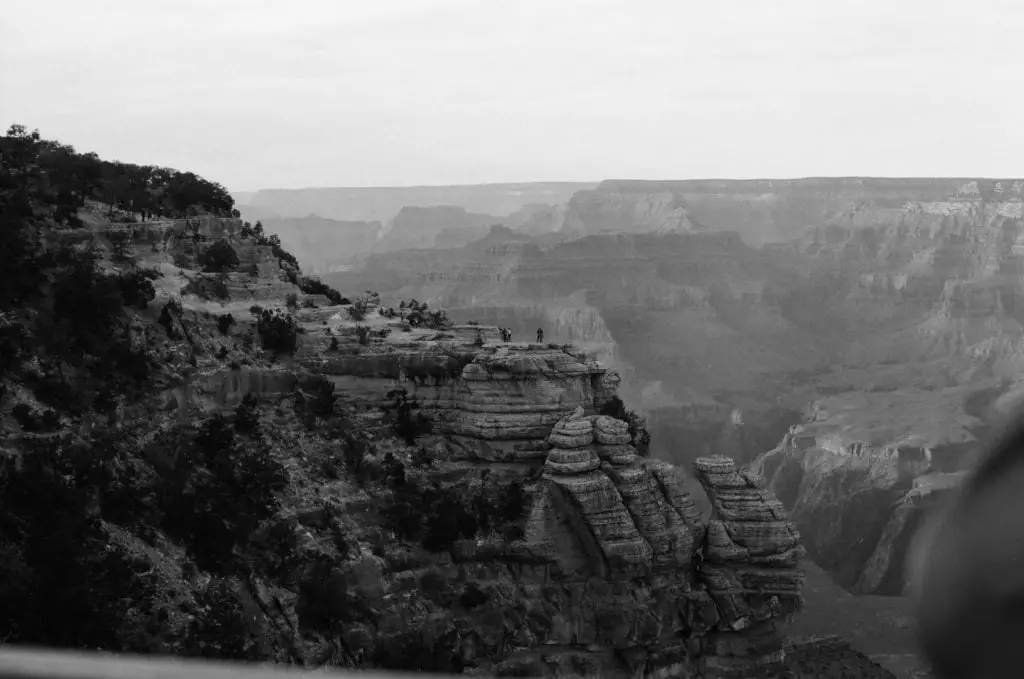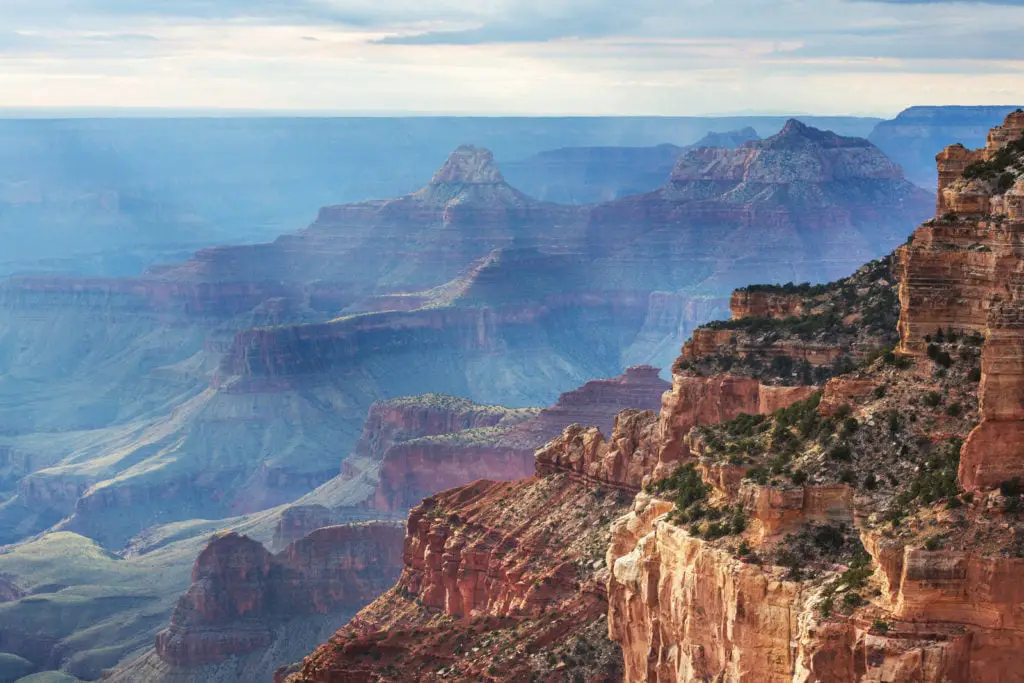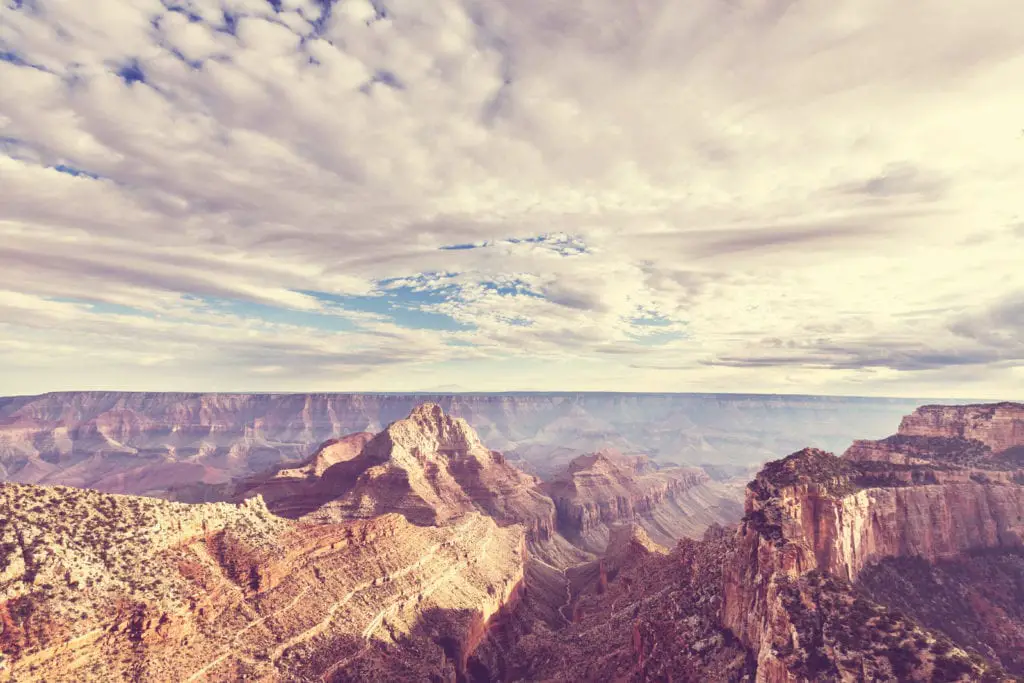Arizona’s biggest and arguably best tourist attraction is the Grand Canyon National Park. The Grand Canyon National Park is located in northern Arizona, west of Las Vegas, Nevada and north of Phoenix, Arizona. Protected by the U.S. National Park Service, the Grand Canyon National Park is one of the United States’ most famous national parks and 1 of the seven wonders of the world.

If you ever have the chance to visit, the trip to the Grand Canyon could be the highlight of your year, and if you do it right, one of the highlights of your life. The park is a huge park, spanning 1,902 square miles. Unless you have weeks on end to visit, you probably can’t see every part of the park in one go.
So, we’ve compiled all of the essentials for you:
- What is the park known for?
- What are the top spots to see?
- Hiking/trails information
- Camping information
- Where to stay
Keep reading to learn all of these tidbits and so much more – by the end of this article, you’ll be ready to hop on your flight and see the wonder that is the Grand Canyon National Park.
1. What Is Grand Canyon National Park Known For?
Most of all, what Grand Canyon National Park is known for is pretty self-explanatory: its grand canyon! The Grand Canyon is 277 miles long, 18 miles wide (at its widest), and has a depth of over a mile (at its deepest). The red, and orange, and yellow rocks are carved by the Colorado River years and years ago, visitors now flock to the Grand Canyon to see the steep-sided canyon, hike in and around it, camp, and even raft down the river.
The Colorado River did wonders to this piece of land. Sculpted by the river for over six million years, the Grand Canyon now is a standing testament to Earth’s geological history. In the canyon, you will see rocks of all colors, buttes, gorges, imposing peaks, and ravines of different colors and sizes. The Grand Canyon is beautifully and carefully carved so that no two areas look exactly the same. And, still flowing through the Grand Canyon is the Colorado River — who knows what the canyon will look like in 10, 50, and 100 years?

The park was established in 1919 and then expanded in 1975. In 1979, it was designated a UNESCO world heritage site. As mentioned, the Grand Canyon National Park is mostly known for the canyon and all of the activities offered within and around the canyon. Additionally, it is well-known for its beautiful nighttime views and delicious food. As there is little to no light pollution, you can see the stars in a way that you’ve never seen them before at the park. There are also a variety of restaurants in the park, serving homemade hot food for the guests who need replenishing.
2. What Are The Top Spots to See in Grand Canyon National Park?
The Grand Canyon National Park is gigantic, so you can imagine how many different amazing viewing points exist within the park. Depending on your preference, you can walk, hike, drive, or even camp to see these spots. While not all are accessible by car or camp, all of the lookout points are accessible by foot and a relatively short distance from your car. There’s no way to decide which spot is the best in the park, but here are some of the most famous and beautiful spots to see, in no particular order.
- Hopi Point
- Yavapai Point
- Maricopa Point
- Mather Point
- Lipan Point
- Cape Royal
- Desert View
- Shoshone Point
- Cape Final
Hopi Point
Hopi Point is located on the southern rim of the Grand Canyon. It is accessible by car or by foot; there is even a shuttle bus starting at the West Rim that will stop at Hopi Point, or plenty of parking space if you come with your own car. At Hopi Point, you’ll see a large vista, Dana Butte, large mesas, and the Colorado River. It’s a great spot for sunsets and a must-see when in the park.
Yavapai Point
Yavapai Point is reachable by Yavapai Point Trail, a moderately challenging hike. The trail runs 3.4 miles round-trip and ends with Yavapai Point, a panoramic view on the southern rim. The trail also offers access to see a variety of other aspects of the park, such as Cottonwood Creek, Pipeline Canyon, and Fireman’s Cove.
Maricopa Point
On the western rim is Maricopa Point, a stunning spot reachable both by foot and car/shuttle bus. This viewpoint is at the edge of the canyon, offering visitors a view over the Grand Canyon with minimal obstructions.
Mather Point
One of the first and easiest viewpoints you may encounter is the Mather Point, an overlook that offers great views of the canyon. It is very close to the Visitor’s Center, so upon arrival you can take a quick stroll to see this viewpoint. There, you can enjoy views of the canyon from the southern rim.
Lipan Point
Another one of the southern rim’s beautiful viewpoints is Lipan Point, located about half a mile north of the main scenic drive. It is situated on top of a small summit, offering visitors an amazing panoramic view. Lipan Point looks over both the Escalante Butte and Seventy-five Mile Creek.
Cape Royal
One of the best spots on the North Rim is Cape Royal, offering visitors a panoramic view of the Grand Canyon. In fact, it is the widest panorama of any viewpoint in the Grand Canyon National Park – definitely don’t miss out on this one. You have to drive quite far to reach Cape Royal, but it is a beautiful drive with an amazing view at the end…totally worth it!
Desert View
Desert View Drive is one of the popular driving routes in the national park. This drive takes you along the southern rim of the Grand Canyon. Desert View itself is a settlement on the South Rim near the east side of the park. At Desert View you’ll find a 70 ft watchtower, unique views of the canyon and the Colorado River, and campground, depending on the season.
Shoshone Point
One of the Grand Canyon’s best kept secrets is Shoshone Point, a view spot off Desert View Drive. Not many people know about Shoshone Point, therefore not many people visit it. It is located on the South Rim and is only open from October to April, as it is reserved for private usage (weddings, events, etc.) the rest of the year. If you’re there when the 2.4 mile round-trip trail is open, definitely go, as you’ll find spectacular panoramic views and solitude.
Cape Final
Our last recommendation is Cape Final, the viewpoint at the Cape Final Trail. It is located on the northern rim of the canyon, close to Cape Royal. The landscape viewable can be seen from one singular point, so it may be one of the most unique viewpoints in the Grand Canyon, as you don’t have to do much walking to see all of the views once you’re there. Cape Final is reachable by a four mile round-trip hike that is fairly easy. It is also a less-known viewpoint, so you can enjoy solitude when there.
These nine spots are all great options for your trip to the Grand Canyon. But, the views don’t stop here. You really can’t go wrong with any of the lookouts at the Grand Canyon, so consult the Visitor’s Center when you get there and see what’s recommended for the season you’re there.

3. Hiking/Trails Information
There are a lot of different ways to hike the Grand Canyon. You can choose between a seemingly endless variety of short one to two hour hikes, whole day hikes, or multiple-day hikes. If you prefer to go with a group, you can also sign up for a group or guided tour.
Day Hikes
The South and North Rim have a variety of popular day hikes; here are some of the top ones:
- South Rim Trail (South Rim): This hike spans from the Grand Canyon Village Area to Hermits Rest, you can begin at any of the viewpoints along Hermits Road or the village area. Trail Level: Easy
- Bright Angel Trail (South Rim): A popular trail on the South Rim, spanning a total of 12 miles round-trip. Best to hike in summer and fall for less-experienced hikers, as there tends to be ice in the winter and early spring. Trail Level: Moderate to Challenging
- Grandview Trail (South Rim): If you’re looking for a challenge, consider the Grandview Trail. This is a great trail if you’re looking to cover multiple hikes in one day, as it offers access to Horseshoe Mesa and Coconino Saddle. Trail Level: Very Challenging
- South Kaibab Trail (South Rim): A good option for a mid-level day hike is the South Kaibab Trail. This 6 mile round-trip trail has beautiful views at the end. It is a steep trail and can be icy during the winter, so ensure you are properly prepared. Trail Level: Moderate
- Roosevelt Point Trail (North Rim): Perhaps one of the quickest but most rewarding hikes is 20 minute round-trip Roosevelt Point Trail. It is a short loop in secluded woodlands, with amazing views at the end. Trail Level: Easy
- Transept Trail (North Rim): A quick introduction to the North Rim is the Transept Trail, an easy hike that follows the northern canyon rim. It is about 3 miles round-trip. Trail Level: Easy
- Ken Patrick Trail (North Rim): This hike starts at Point Imperial and ends at the North Kaibab Trail parking lot. It is 10 miles, about six hours in total; the Ken Patrick Trail is a one-way hike. Trail Level: Moderate
- North Kaibab Trail (North Rim): The North Kaibab Trail offers both day hikes and multiple-day hikes, depending on how far you’d like to go. It is one of the only trails that offers day-hikers access into the canyon and is a great option for those of you who aren’t doing multiple-day hikes, but still want to do a challenging hike and enjoy all the canyon has to offer. Trail Level: Varies
These trails/hikes are a good place to start when deciding what to do at the Grand Canyon National Park. You should definitely visit both the North and South Rim, so consider picking and choosing between trails that offer you access to both.
Multi-Day Hikes
If you’re interested in multi-day/backpacking hikes, here are some of the best and most popular ones:
- Escalante Route
- Horseshoe Mesa Circuit
- Hermit/Tonto/Bright Angel
- Grandview/Tonto/Bright Angel
- South Kaibab/Bright Angel
- North Kaibab
These multi-day hikes run up to 35 miles round-trip and span between two to five days, generally. Depending on whether you go with a guide or alone, you can set the pace based on your hiking experience. These are for experienced hikers only and require reservation and planning in advance, so if you’re thinking about backpacking, make sure to plan ahead.
Hiking Pro-Tips:
- Check out trail-specific information depending on the season you’re visiting; summer weather and winter weather can vary greatly, so ensure that you’re prepared for the climate.
- Take care of the land that you’re visiting. Read up on the Trail Courtesy Practices and don’t leave any trash or waste lying around.
- Read the official Hiking Tips page from the National Park Website; they’ll teach you best practices for the Grand Canyon specifically.
- Water is offered at some places along the trails, but be sure you bring enough snacks and water with you. You can find out more information about water from the trail maps or Visitor’s Center.
4. Camping Information
You can, of course, camp in the Grand Canyon. We mentioned that the nighttime views in the park are spectacular – one of the best ways to see the stars, enjoy the nature, and bask in the solitude is through camping.
There are four developed campgrounds in the Grand Canyon National Park. The developed campgrounds are located around the North and South Rim and vehicles are permitted. If you are interested in camping anywhere in the park aside from these four campgrounds, you will need a Backcountry Permit.
Here’s some more information on the developed campgrounds:
- Mather Campground on the South Rim is located in the Grand Canyon Village and open all-year round. Advance reservations are required.
- North Rim Campground is located on the North Rim and open May 15 through October 31. Advance reservations are required.
- Trailer Village is open all-year round and is an RV park with full hook-ups, located on the South Rim. Advance reservations are required.
- Desert View Campground is open mid-April through mid-October and is on the southern rim. This campground is first-come first-serve.
Be sure to check the official website for any changes and new information regarding the campground regulations. It’d be good to plan ahead for any campgrounds that need reservations. As many people fly in from all over the world to visit the Grand Canyon, campgrounds can get fully reserved up to six months in advance.
5. Where To Stay in Grand Canyon National Park
Grand Canyon National Park is very well-equipped with different accommodation types. As they receive millions of tourists each year, there are plenty of lodging options, ranging from actual lodges to camping.
Grand Canyon Village
There are official Grand Canyon National Park lodges in the park, in both the South Rim and North Rim. They’re located in Grand Canyon Village, which is the most popular place to stay. It’s a nice little settlement, with both permanent residents and tourists.
The lodges tend to get fully booked months in advance, so if this is your accommodation option of choice, definitely book ahead. The South Rim has some lodges that are open all year-round and some that are seasonal, closed for the winter. The North Rim only has seasonal lodges that are open for the summer season. Dependent on the lodge, you can find accommodation that let you bring your pets, hook up your RV, and more.
Other Options
If you don’t stay in the park, you still have plenty of options. You can find lodges just outside of the Grand Canyon that are well-equipped and some offer shuttle transportation to the park daily; take a look at this list from the official website. Or, you can stay at a hotel near the park, perhaps in the town of Williams.
Williams is a good option if you don’t stay in Grand Canyon Village, as it is a small quaint town right off of the freeway with everything you need from transportation to the park, food, restaurants, and shops. You could even spend a day or two exploring Williams and all the character it has to offer. Tuba City and Page are also a couple of the other cities somewhat close by that offer accommodations and options for your stay.
If hotels and lodges aren’t for you, consider AirBnBs or camping within or outside of the park. If you choose to camp, make sure to reserve your spot in the campground in advance.
As you can see, the Grand Canyon National Park has options for everyone. From one hour hikes to five day hikes, car tours, hotels, and more, whether you are five or fifty-five, you are sure to enjoy your trip to the Grand Canyon. Our one big tip is to plan in advance for this vacation, but other than that, just being in the park will give you a great taste of what this spot on the Earth has to offer.
Please read 2 of our other articles that will help you as you plan your visit to the Grand Canyon: 1. This is How Much Time To Expect Spending At The Grand Canyon. 2. 12 Places to Eat During Your Stay in the Grand Canyon.

